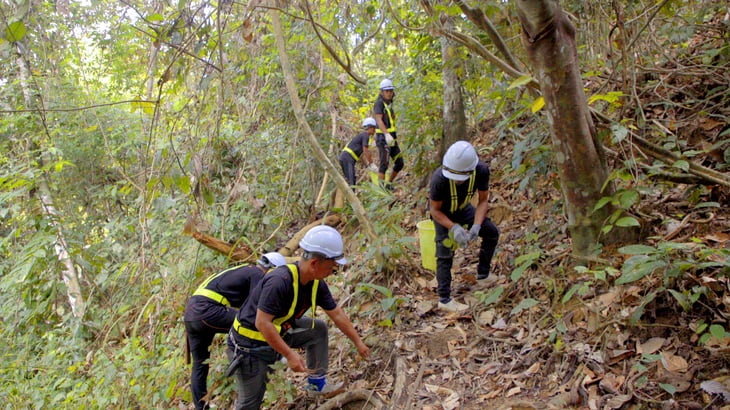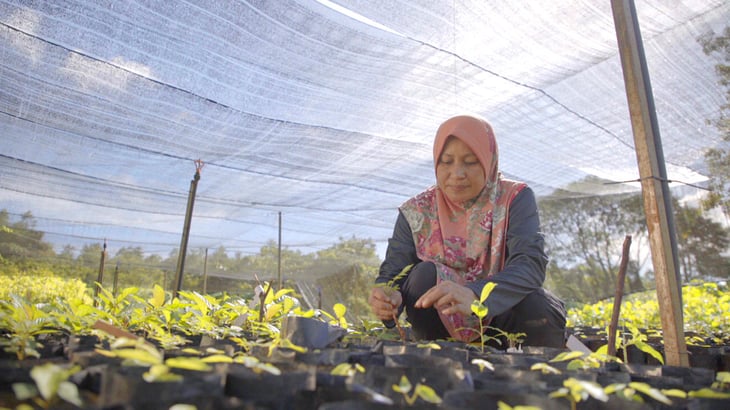Saving the Dipterocarp Species
ArticleOctober 23, 2022
In 2010, fifty-five years after the last record of a Dipterocarpus lamellatus in Sabah, the tree species was rediscovered by a research team from the Forestry Department. It was a significant discovery that brought the rare species “back to life”.
While the Dipterocarpus lamellatus had a happy conclusion, we must not take for granted the other dipterocarps that we have in our tropical rainforests’ backyard. In fact, biologist E.O. Wilson estimates that we lose about 137 plant, animal and insect species every day. Dipterocarps, also known as ‘Forest Giants’, are tropical hardwood trees that play a critical role in providing numerous types of valuable resources. Although Malaysia’s rainforests are dominated by these species, 62% of Bornean endemic dipterocarp species are currently under threat and listed under the IUCN Red List.

"Dipterocarps begin their journey to growth at the nursery." Photo credit: TRCRC
One of the main threats to dipterocarps is logging. The timber from dipterocarps is used as building materials and the issue lies in that the extraction of these trees is done at a much faster rate than its growth. With more and more trees getting extracted, there are fewer tree species that can produce seed for natural regeneration.
The habitats of these dipterocarps also get destroyed through land conversion. Certain dipterocarp species are endemic to certain areas which limits their natural dispersal of seeds as their habitat is taken away. These trees already struggle to germinate as seed predators tend to be in the vicinity during fruiting season. There is no customary way to avoid these seeds from being consumed as fruiting season is unpredictable when triggered by changes in weather patterns.

"Zurich Malaysia is collaborating with TRCRC to help build healthier dipterocarps forest." Photo credit: TRCRC
How does this impact the forest ecosystem
Dipterocarp species are not the only species losing their habitats in the process. All wildlife is generally affected by the loss of the dipterocarp species. Dipterocarp forests act as a habitat and shelter for wildlife. Biodiversity is intertwined and all species are interdependent on each other’s survival. A great example of this biodiversity and dependency are the orangutans that build their nests in trees, smaller mammals such as black-banded squirrels, tarsiers, and leopard cats that hunt along the forest floor. Losing these forests, means these animals lose their homes too.
In the past few years, efforts from conservation groups such as Tropical Rainforest Conservation and Research Centre (TRCRC) to build healthier and more functional dipterocarp forests are slowly bearing fruit.
TRCRC’s site in Merisuli, Sabah has welcomed the return of certain species in the area. Elephants, orangutans, hornbills as well as a wide variety of insects and amphibians are making their way home. Furthermore, as the trees begin to mature, there will be a greater improvement of biodiversity in that area.

"Nurturing dipterocarp seedlings to prepare them for growth in the forest." Photo credit: TRCRC
The key to a successful restoration project is to make strategic decisions, bound by facts and nature. A large amount of focus goes into dipterocarps. However, these are not the only trees that play a role in forest restoration.
The planting of numerous other pioneer species, wild fruit trees and fast-growing species play their own role in contributing to a functional ecosystem that will require little to no human intervention in the future. These pioneer species’ goal is also to help prepare the land by restoring balance to the soil, attracting pollinators and other wildlife to the area which enhances the forest’s biodiversity. Dipterocarps need these other species around as they require a land suited to their features to grow and expand among the regions. With that said, the dipterocarp species are an important part of Malaysia’s biodiversity, and we hope this inspires you to take action to conserve the various tree species for future generations.
The article was produced with input contributed by TRCRC.
